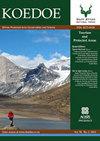Hydrological response in a savanna hillslope under different rainfall regimes
IF 1.1
4区 环境科学与生态学
Q3 BIODIVERSITY CONSERVATION
引用次数: 4
Abstract
Savannas are currently experiencing extensive population and agricultural water resource pressure globally (Rockström et al. 2014). Because we are now moving into an era of adaptive management of ecosystems where information on state change thresholds is a prerequisite for their sustained management, it is necessary to invest in understanding the biophysical processes that maintain these systems. In savanna landscapes, soil water is the direct link between precipitation and ecological patterns (Weltzin et al. 2003). The co-domination by trees and grasses is bound by soil water availability, a key factor in establishing form and function. Therefore, spatial soil moisture dynamics is a crucial link in the equilibrium between climate, soil and vegetation in these systems (Rodriguez-Iturbe et al. 1999). The resulting hydrological processes contribute to the biophysical template of these semi-arid systems, controlling the distribution of water and other resources along a continuum within the landscape, which often comprises compound effects of non-linear relationships and thresholdtriggered responses. Given this complexity, novel interdisciplinary approaches should be sought to understand hydrological processes in such heterogeneous landscapes (Troch et al. 2008). Moreover, inter-disciplinarity is increasingly valuable for successful landscape management, given the emphasis on hydrological connectivity at landscape scale (Michaelides & Chappell 2009).不同降雨条件下稀树草原山坡的水文响应
稀树草原目前正面临着全球范围内广泛的人口和农业水资源压力(Rockström et al. 2014)。因为我们现在正进入一个生态系统适应性管理的时代,在这个时代,状态变化阈值的信息是其持续管理的先决条件,因此有必要投资于理解维持这些系统的生物物理过程。在稀树草原景观中,土壤水分是降水和生态模式之间的直接联系(Weltzin et al. 2003)。树木和草的共同支配受土壤水分有效性的制约,土壤水分有效性是形成形态和功能的关键因素。因此,空间土壤水分动态是这些系统中气候、土壤和植被平衡的关键环节(Rodriguez-Iturbe et al. 1999)。由此产生的水文过程有助于形成这些半干旱系统的生物物理模板,控制着景观内沿连续体的水和其他资源的分布,这通常包括非线性关系和阈值触发响应的复合效应。鉴于这种复杂性,应该寻求新的跨学科方法来理解这种异质景观中的水文过程(Troch et al. 2008)。此外,鉴于强调景观尺度上的水文连通性,跨学科对成功的景观管理越来越有价值(Michaelides & Chappell 2009)。
本文章由计算机程序翻译,如有差异,请以英文原文为准。
求助全文
约1分钟内获得全文
求助全文
来源期刊

Koedoe
BIODIVERSITY CONSERVATION-
CiteScore
3.30
自引率
0.00%
发文量
10
审稿时长
20 weeks
期刊介绍:
Koedoe, with the subtitle ''African Protected Area Conservation and Science'', promotes and contributes to the scientific (biological) and environmental (ecological and biodiversity) conservation practices of Africa by defining the key disciplines that will ensure the existence of a wide variety of plant and animal species in their natural environments (biological diversity) in Africa.
 求助内容:
求助内容: 应助结果提醒方式:
应助结果提醒方式:


